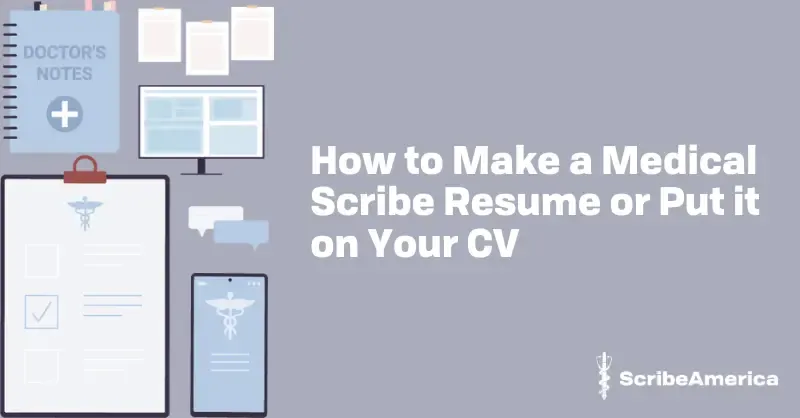Key points:
- Tailor your resume to the role – Highlight relevant education, transferable skills, and nonmedical abilities (like typing speed, accuracy, and communication), while keeping unrelated experience concise.
- Showcase your medical scribe experience effectively – Emphasize the software you used, the specialists you worked with, measurable data (WPM, accuracy), and key achievements to stand out.
- Presentation matters – Keep your CV clear, concise (1–2 pages), visually appealing, and error-free, as attention to detail is critical in medical scribing roles.
There are three sure things in life: death, taxes, and the fact that you will write a resume at least once in your life if you wish to work. Do you know what else connects these three? The amount of stress related to them. Creating a comprehensive CV might be difficult, no matter whether you have experience or not. Thus, in this article, we aim to help you. We will focus here on two situations: writing a resume for the medical scribe position and putting medical scribe experience on your CV. We encourage you to read on!
How to Make a Resume For a Medical Scribe Opening?
If you wonder how to get a job as a medical scribe, a strong CV is a must. Often, it is the first impression that you can make on your potential employer. If you wish for your resume to attract attention, you need to make it brief yet on the subject. Here are a few tips:
- List all your experience – Make sure to include all your previous positions, but make those unrelated to the medical scribe job short. The aim of that is to prove that you are willing and dedicated to work, yet without taking too much space. After all, you only want to prove that you were working – the recruiter won’t be interested in details.
- Underline your education – If you are writing a resume for a medical scribe opening with no experience, the main focus should be on your education. Did you participate in some healthcare-related competitions? Which medical-oriented courses did you take? Elaborate on that if you have no medical experience.
- Highlight transferable skills – If you’re wondering how to make a resume for medical scribe roles, it’s vital to showcase skills that translate well into the position. For example, customer service experience can emphasize your communication skills, while retail jobs might demonstrate your ability to work under pressure and handle multitasking.
- Don’t forget the nonmedical skills – A medical scribe is required more than just to know the terminology and regulations. They need to be able to type quickly, transcribe accurately, and have excellent communication skills. Focusing purely on healthcare won’t land you the job – you need to highlight these skills as well. So, even if your experience doesn’t seem relevant – it might be, to some extent.
- Use strong, action verbs – You can find this tip among numerous CV writing guides for a reason. These are meant to show that you accomplished something, not just been responsible for it. Using action verbs can drastically improve the way a recruiter perceives your medical scribe resume.

How to Put Medical Scribe Experience on Your Resume?
You have probably scrolled through tens of sample medical scribe CV, but you still struggle to choose one that fits you, right? Well, there are quite a few aspects that you should focus on. The final form will depend on what position you are applying for, yet here are some general guidelines:
- List the software you used – This can be crucial for other medical administration jobs.
- Underline what specialists you worked with – It might be quite beneficial if you have graduated from med school and now wish to work as a physician yourself.
- Use data – Don’t be afraid to include your transcription accuracy rate or average words per minute typing speed (If you want to increase your typing speed, read our article: How to Improve Typing Speed and Accuracy? Tips on How to Become a Fast Medical Scribe.
- Include your biggest achievement – It will show the employer that you were truly dedicated and successful.
How to Put Typing Speed on Resume?
Typing speed is one of the most valued skills for a medical scribe, as your role involves transcribing information quickly and accurately during patient encounters. To include it effectively, place your typing speed under the skills section of your resume. Use a clear format such as “Typing speed: 80 WPM with 98% accuracy” to demonstrate both speed and precision. If you’ve improved your typing skills through training or practice, you can also mention it under professional development or certifications. This will show employers your commitment to excelling in the role.
How to Put Words Per Minute on Resume?
Words per minute (WPM) is the most common metric to measure typing efficiency, and employers in healthcare appreciate seeing it clearly on a CV. You can highlight your WPM in the skills summary at the top of your resume or in a dedicated technical skills section. If your typing speed is exceptional, you may also reference it in the experience section by noting it alongside your past responsibilities (e.g., “Maintained 85 WPM while transcribing medical documentation with 97% accuracy”). This reinforces both your technical ability and your attention to detail, which are essential for medical scribing.
What to Keep in Mind When Creating a Medical Scribe Resume?
Writing a resume for medical scribe doesn’t have to be hard – no matter whether you are applying for this job or it’s a part of your experience. Remember that your CV should make it into 1–2 pages and needs to be attractive visually – you want the recruiter to spot you.
Proofread meticulously – Errors in a CV, especially for roles requiring attention to detail like medical scribing, can harm your chances. Proofread your medical scribe resume thoroughly before submitting it.
Do you want to become a medical scribe? Read our article on how to prepare for a medical scribe interview.




